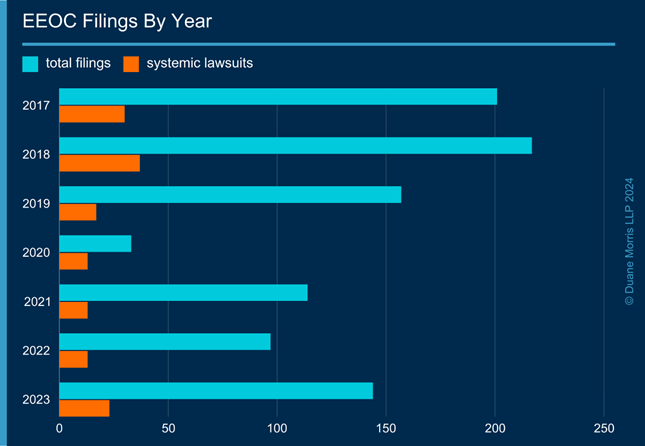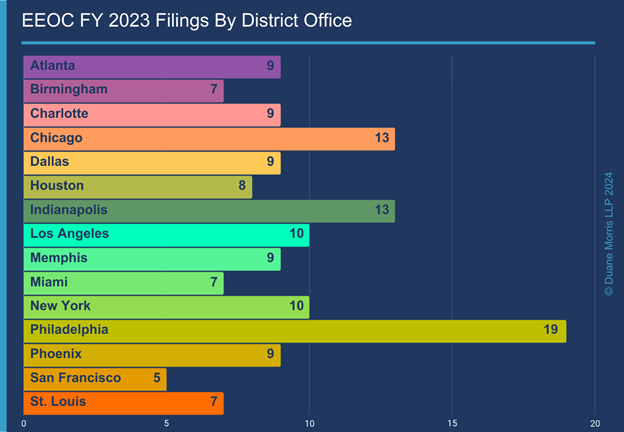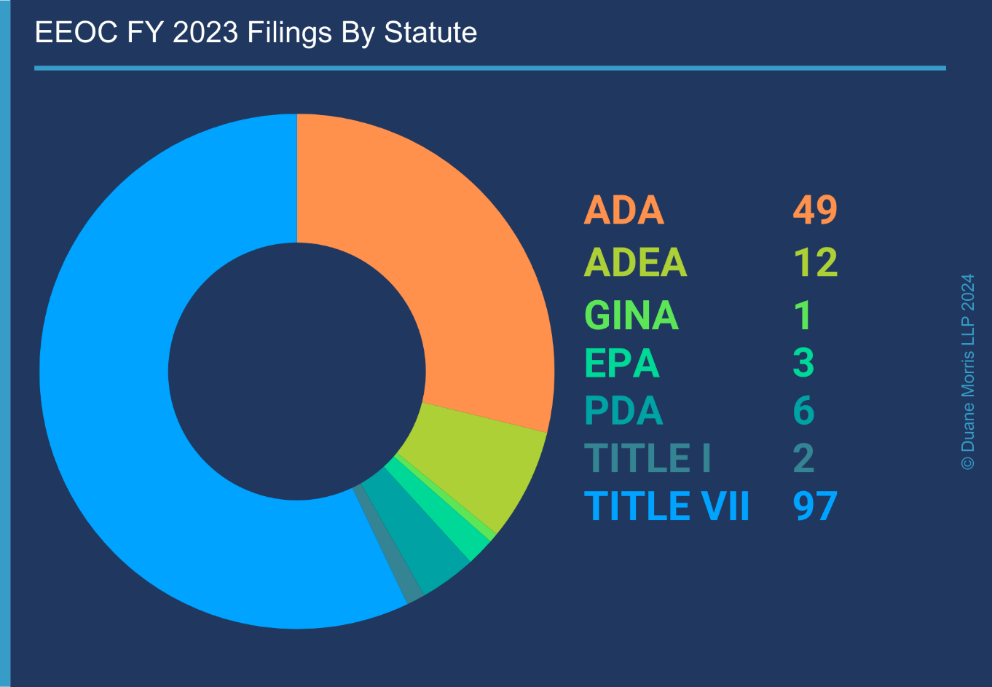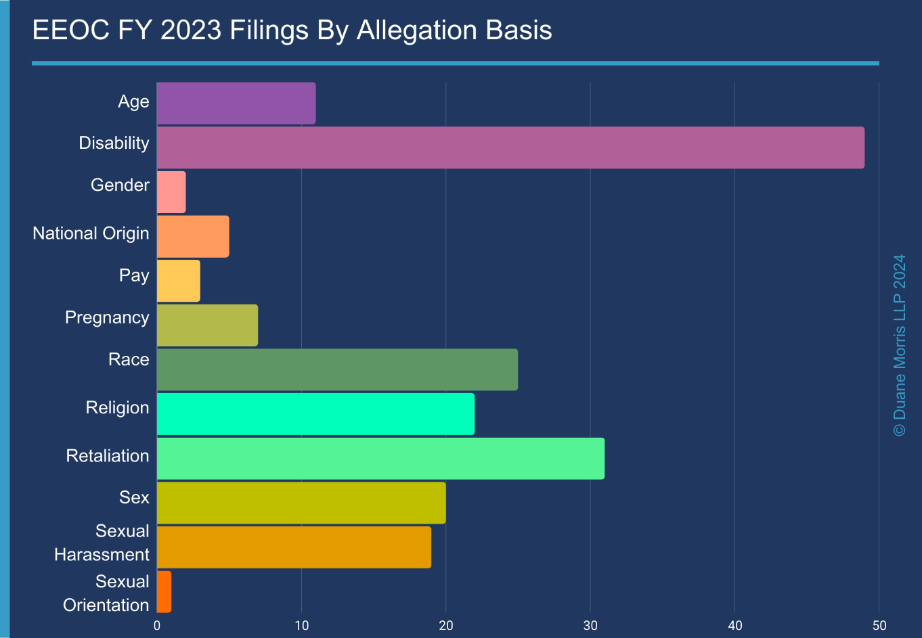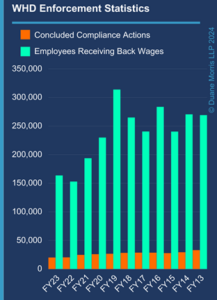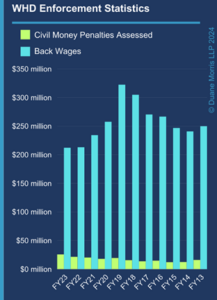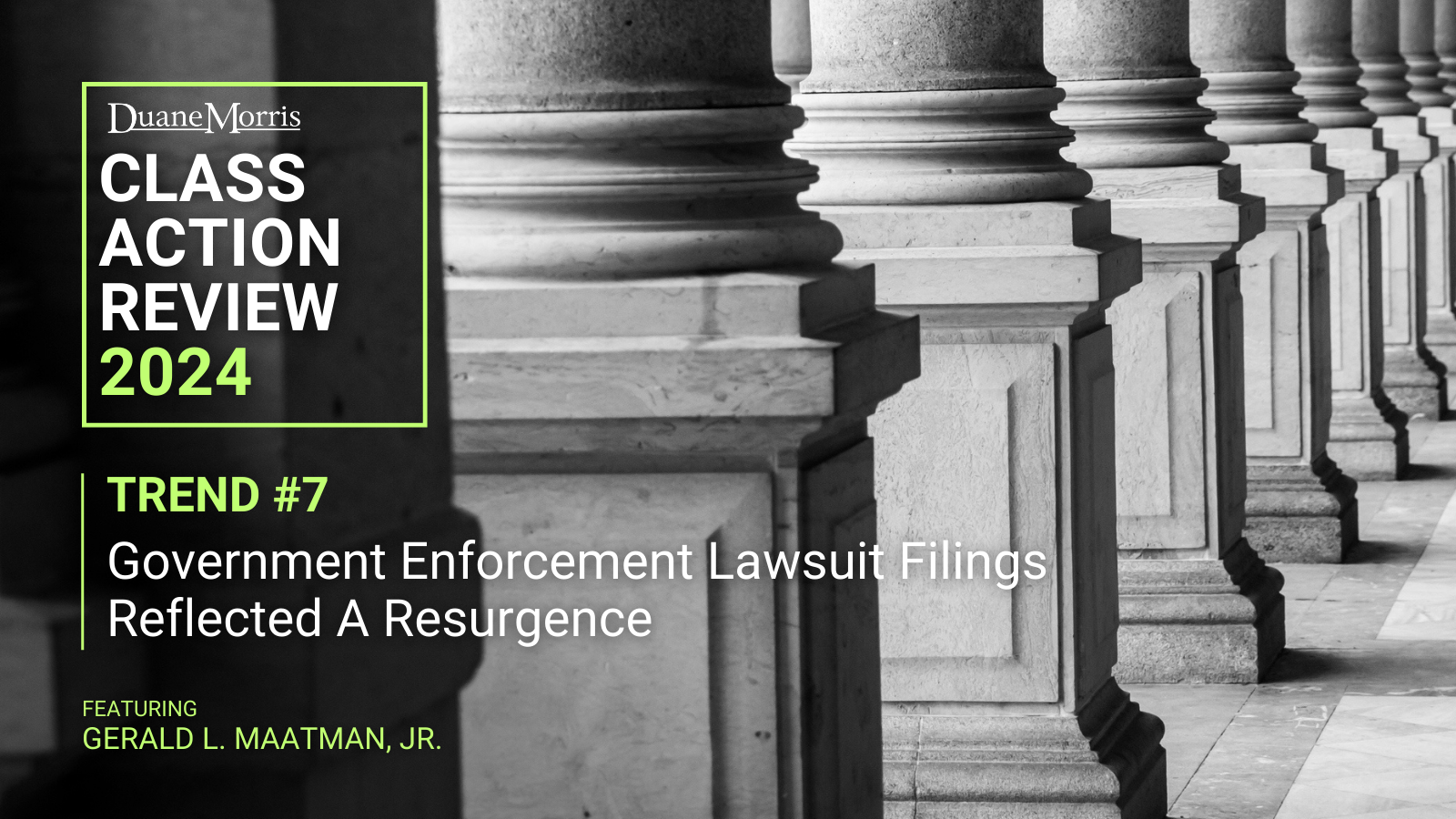
By Gerald L. Maatman, Jr. and Jennifer A. Riley
Duane Morris Takeaway: In 2023, the EEOC’s litigation enforcement activity showed that its previous slowdown in filing activity is well in the rearview mirror, as the total number of lawsuits filed by the EEOC increased from 97 in 2022 to 144 in FY 2023.
In accordance with tradition, the EEOC filed more lawsuits in September 2023, the last month of its fiscal year, than in any other month from October 2022 forward. This past year, the EEOC filed 67 lawsuits in September, up from 39 filed in September 2022.
Watch below as Duane Morris partner Jerry Maatman addresses the top Trends in Government Enforcement Litigation in 2023, and what to expect in this area in 2024.
DMCAR Trend #7 – Government Enforcement Lawsuit Filings Reflected A Resurgence
The EEOC exhibited a renewed focus on systemic discrimination lawsuits. “Systemic” discrimination, according to the EEOC, involves an alleged “pattern or practice, policy and/or class … where the discrimination has broad impact on an industry, profession, company, or geographic location.” The EEOC filed 25 systemic lawsuits in FY 2023, nearly double the number it filed in each of the past three years. Overall, the 2023 lawsuit filing data and strategic priorities confirm that aggressive EEOC enforcement activity is back on the menu, and the litigation filing machine is back in full throttle, with no signs of slowing down.
- Litigation And Settlement Trends
In FY 2023, the EEOC filed 144 lawsuits, including 25 systemic lawsuits. This represents a resurgence from what we observed in FY 2022, during which the EEOC filed 97 lawsuits, including 13 systemic suits. These enforcement numbers reflect a boost over filing numbers from FY 2021, as well, during which the EEOC filed 114 lawsuits including 13 systemic lawsuits. They likewise reflect an increase over FY 2020, during which the COVID-19 pandemic pushed case filings down to 33.
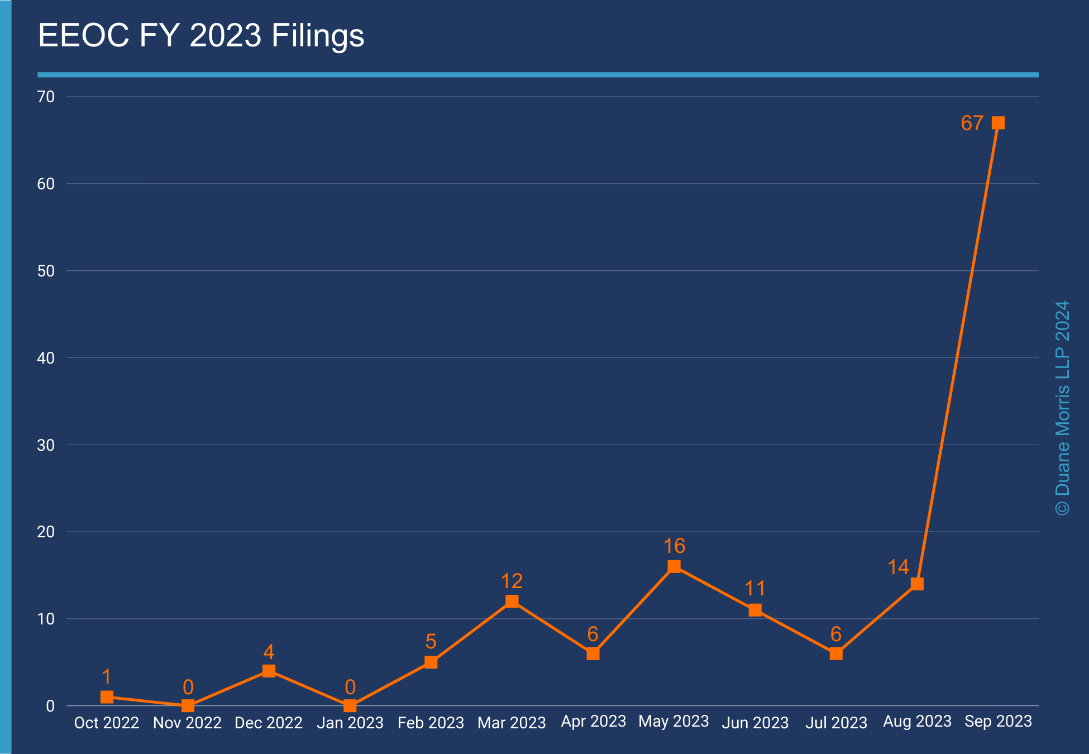
The graphic shows this year-over-year filing trend:
As illustrated, FY 2023 represents the highest number of filings since FY 2019, during which the EEOC filed 157 lawsuits. These numbers remain off the high water marks we observed in prior years, including 217 lawsuits in FY 2018 and 201 lawsuits in FY 2017.
Notably, FY 2023 also reflected a resurgence in the filings from historically active district offices. In FY 2023, Philadelphia District Office had by far the most lawsuit filings with 19, followed by Indianapolis and Chicago with 13 filings, and New York and Los Angeles each with 10 filings. Charlotte, Atlanta, Dallas, Phoenix, and Memphis had 9 each, Houston had 8, Miami, Birmingham, and St. Louis had 7 each, and San Francisco had 5 filings.
The following shows the filing numbers in FY 2023 by district office:
The 19 filings by the Philadelphia District Office reflects a significant increase compared to FY 2022 during which Philadelphia filed 7 lawsuits. Similarly, Indianapolis nearly doubled its filings compared to FY 2022. The number of lawsuit filings by the Chicago District Office remained steady at 13. The filings by the Miami District Office fell slightly to 7, compared to its 8 filings in FY 2022.
The balance across various District Offices throughout the country confirms that the EEOC’s aggressiveness is in peak form, both at the national and regional level.
As to systemic filings, the EEOC filed 25 systemic lawsuits in FY 2023, almost double the number it filed in each of the past three fiscal years and the largest number of systemic filings in the past five years. As to its current docket, in FY 2023, the EEOC reported that it had a total of 32 systemic cases on its docket at the end of fiscal year 2022, accounting for 18% of its active merits suits. During FY 2022, the EEOC reported 29 pending systemic cases, which accounted for 16% of the EEOC’s docket.
While these numbers continue to climb, they do not yet reflect the activity that employers observed prior to FY 2018. By the end of FY 2018, the EEOC had 71 systemic cases on its active docket, two of which included over 1,000 victims, and systemic cases accounted for 23.5% of its active docket in that year.
Comparing its monetary recovery to previous years, the EEOC reported that it recovered $513.7 million in all types of cases in FY 2022, an increase over its reported recovery in FY 2021, during which it recovered, $485 million. Comparing the numbers to prior years, the EEOC recovered $535.5 million in all types of cases in FY 2020, $486 million in FY 2019, and $505 million in FY 2018.
The below chart shows the year-over-year change in total recoveries.
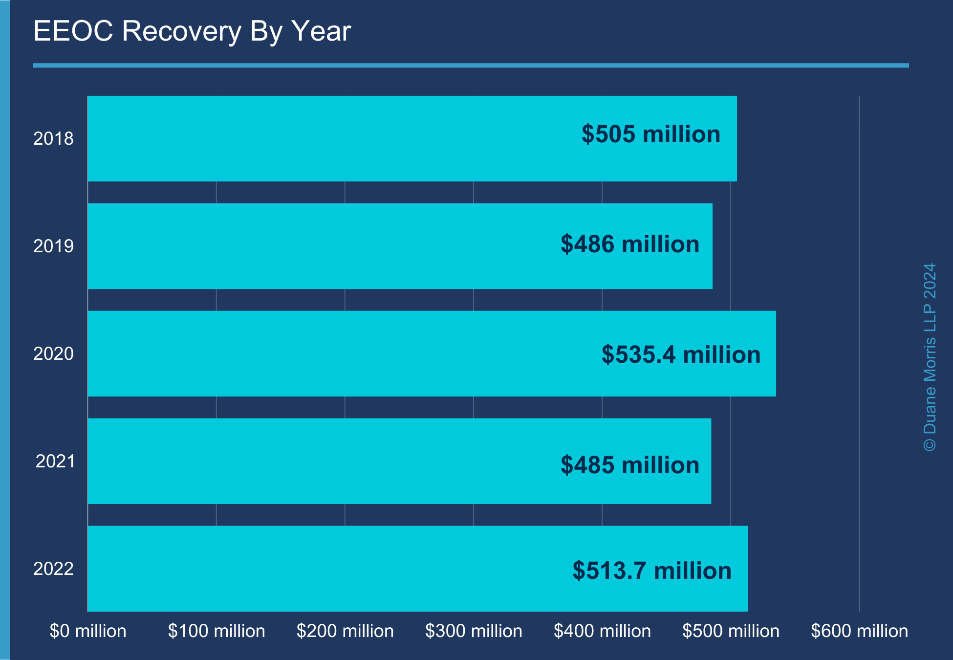
In terms of the types of filings, FY 2023 remained generally consistent with prior years in that the EEOC filed the bulk of its lawsuits under Title VII, the Americans with Disabilities Act (“ADA”), and the Age Discrimination in Employment Act (“ADEA”).
Title VII cases once again made up the majority of cases filed. The EEOC filed 97 cases under Title VII, making up 68% of all filings (down from 69% of filings in FY 2022 and above 61% of filings in FY 2021).
The EEOC filed more cases under the ADA this past year with 49 lawsuits, nearly twice the number of ADA lawsuits it filed in FY 2022, and, as a percentage of all filings, ADA lawsuits increased from 29.7% in FY 2022, to 34% of lawsuit filings in FY 2023.
The EEOC filed 12 ADEA lawsuits in FY 2023, an increase from the 7 ADEA lawsuits it filed in 2022.
The following graphs show the number of lawsuits filed according to the statute under which they were filed (Title VII, Americans with Disabilities Act, Pregnancy Discrimination Act, Equal Pay Act, and Age Discrimination in Employment Act) and, for Title VII cases, the theory of discrimination alleged.
Amplifying its renewed activism, the EEOC issued a press release at the end of the fiscal year touting its increased enforcement litigation activity. Such a media statement is unprecedented in that 2023 is the first year the EEOC issued a media statement touting its numbers, a signal that its renewed activity reflects a strategic priority.
In July 2023, the Senate confirmed Kalpana Kotagal, President Biden’s nominee to fill the fifth Commissioner slot, for a term expiring in July 2027. Upon her confirmation, Democrats gained a 3 to 2 majority among Commissioners. Employers are apt to see increased litigation enforcement activity in 2024 as the EEOC continues to gain momentum with its full component of Biden appointees and can utilize its majority power to advance its agenda.
- What’s Next For The EEOC?
Now that the EEOC has a majority of Democratic-appointed Commissioners firmly in place, along with a significantly increased proposed budget, we expect that Corporate America will see a continued expansion of enforcement activity in 2024.
Every few years the EEOC prepares a Strategic Enforcement Plan to focus and coordinate the agency’s work and identify subject matter priorities. This year, the EEOC released its Strategic Enforcement Plan for Fiscal Years 2024-2028.
In the 2024-2028 Strategic Enforcement Plan, the EEOC identified three guiding principles. First, the Commission states that to maximize the EEOC’s effectiveness, it will focus on those activities that have the greatest strategic impact, including systemic investigations, resolutions, and lawsuits. The EEOC thus “reaffirms its commitment to a nationwide, strategic, and coordinated systemic program as one of the EEOC’s top priorities.”
Second, the EEOC states that it will take an integrated approach at the agency that promotes collaboration, coordination, and information sharing throughout the agency. It explains that “[e]ffective systemic enforcement requires communication and collaboration between the EEOC’s legal and enforcement units, between headquarters and the field, and across EEOC districts.”
Third, the EEOC states that it will ensure that it achieves results “in accordance with the priorities set forth in the [Strategic Enforcement Plan].” This signals that the Commission will continue to emphasize and prioritize the use of systemic, pattern or practice lawsuits to accomplish its agenda.
As in years past, the Strategic Enforcement Plan also sets out the EEOC’s six substantive priorities.
#1 – Eliminating Barriers In Recruitment and Hiring – The EEOC will focus on recruiting and hiring practices that discriminate, including, among other things the use of technology, including artificial intelligence and machine learning, to target job advertisements or assist in hiring decisions; job advertisements that exclude or discourage certain protected groups from applying; and the use of screening tools or requirements that disproportionately impact workers on a protected basis, including those facilitated by artificial intelligence or other automated systems.
#2 – Protecting Vulnerable Workers – The EEOC will focus on harassment, retaliation, job segregation, discriminatory pay, disparate working conditions, among other things, that impact “particularly vulnerable workers,” which include immigrant and migrant workers; people with developmental or intellectual disabilities; individuals with arrest or conviction records; LGBTQI+ individuals; temporary workers; older workers; individuals employed in low wage jobs, including teenage workers; among others.
#3 – Addressing Selected Emerging And Developing Issues – The EEOC will continue to prioritize issues that may be emerging or developing, which includes qualification standards and inflexible policies or practices that discriminate against individuals with disabilities; protecting workers affected by pregnancy, childbirth, or related medical conditions; and addressing discrimination influenced by or arising as backlash in response to local, national, or global events.
#4 – Advancing Equal Pay Protections for All Workers – The EEOC will continue to focus on combatting pay discrimination in all forms. It notes that, because many workers do not know how their pay compares to their co-workers’ pay and, therefore, are less likely to discover and report pay discrimination, the EEOC will continue to use directed investigations and Commissioner Charges to facilitate enforcement.
#5 – Preserving Access to the Legal System – The EEOC will focus on policies and practices that discourage or prohibit individuals from exercising their rights or impede the EEOC’s enforcement efforts, including, among other things, overly broad waivers, releases, or non-disclosure agreements; and unlawful, unenforceable, or otherwise improper mandatory arbitration provisions.
#6 – Preventing and Remedying Systemic Harassment — The EEOC will continue to focus on combatting systemic harassment in all forms. It notes that, with respect to charges and litigation, a claim by an individual or small group may fall within this priority if it is related to a widespread pattern or practice of harassment.
Some – but certainly not all – of the EEOC’s lawsuits initiated over the past year fall into one or more of these six categories. The EEOC’s focus on systemic litigation underlies many of these enforcement priorities. Because the EEOC views systemic cases as having a particular strategic impact, insofar as they affect how the law influences a particular community, entity, or industry, companies should brace for the expansion of these cases.
- Department Of Labor Enforcement Year-End Recoveries
The US Department of Labor’s Wage and Hour Division recovered approximately $212.3 million in back wages in FY 2023 and concluded 20,215 compliance actions. These numbers align with the numbers we saw in FY 2022, in which the WHD recovered $213.2 million in back wages and concluded 20,422 compliance actions. The number of compliance actions, and the subsequent back wages recoveries in FY 2022-23 was measurably lower than in FY 2021 and FY 2020. In FY 2021, the WHD concluded 24,746 compliance actions and recovered $232.4 million in back wages and in 2020 it concluded 26,096 compliance actions and recovered $257.8 million in back wages.
Although the WHD back wages recoveries were down, the agency imposed civil money penalties to employers at a 10-year-high of $25.8 million for violations of federal labor laws in FY 2023. This was the highest number in a decade, and was significantly higher than the penalties assessed in 2022 ($21.6 million), 2021 ($20.4 million), and 2020 ($17.9 million).

